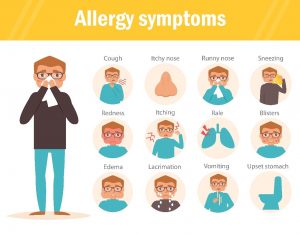Your go-to guide
Every year, researchers across Australia and the globe are devoting time and resources to discovering the underlying causes of allergies. According to Allergy & Anaphylaxis Australia, food allergies alone affect 1 in 50 adults and 1 in 20 children across the nation.
Severe food allergies, such as nut and seafood allergies, often have parents extremely concerned about their child’s health and any potential risks.
So, what do you need to know? Here are the answers to all your common questions about food allergies from our after-hours doctors.
What are the signs of an allergic reaction?
There are many symptoms of an allergic reaction, both for children and adults, that can often go unnoticed. It is important to look for the following signs in the event you, or someone you know, might be having an allergic reaction:
- Tingling mouth
- Swelling of the face, lips and eyes
- Wheezing, difficulty breathing or asthma symptoms
- Vomiting, diarrhoea or nausea
- Abdominal pain
Introducing new foods to babies and children can be concerning, particularly when it comes to food allergies. Make sure to look for the below symptoms when giving your child new foods:
- Difficulty breathing
- Tongue or face swelling
- Flushed skin or rashes
- Hives
- Coughing or wheezing.
In the event your child has difficulty breathing and/or swelling of the tongue or throat, seek medical attention right away. Our team of after-hours doctors also stress it is important to remember less severe reactions can take several days to appear and might include eczema, diarrhoea or constipation.
How to diagnose a food allergy
Though a food allergy usually causes a reaction each time the trigger food is eaten, the symptoms of this reaction can differ from person to person and may vary every reaction. As it is difficult to predict how severe a potential reaction can be, it is important all people with food allergies are aware about the risk of anaphylaxis, fatal reactions and how to treat symptoms.
Before doing this however, a food allergy needs to be correctly diagnosed either by a doctor or allergist. Food allergies can be developed at any age, not just during childhood, so you should be aware if you suspect you may have a food allergy.
If you are concerned you, or a loved one may have a food allergy, you can see an allergist who will take an in depth look at your medical and family history along with any symptoms you have noticed. Questions you may be required to answer may include:
- Foods you have eaten and how much
- How long it has taken the signs to have developed since you have eaten specific foods
- What specific symptoms you have experienced, and for how long.
As well as this, an allergist can decide on which tests to perform if needed.
These tests can include:
- Skin-prick tests – these tests can typically provide results in less than an hour. They are performed by placing a liquid on your skin containing the food allergen (often on the arm or back). The skin will then be pricked with a small probe where the liquid is able to seep under the skin. Allergists are able to determine whether you have an allergy if a wheal (similar to a bump from an insect bite) develops where the skin was pricked.
- Blood tests – these tests can provide results in approximately one week. They are performed by measuring the amount of Immunoglobulin E (lgE), an antibody synthesised by plasma cells, to the specific food being tested.
Treatments for food allergies
The treatment of a food allergy typically depends on severity of the symptoms, or reaction. Mild to moderate symptoms (for example, sneezing or rashes) can often be treated with antihistamines. These can include over the counter medications such as Zyrtec or Sudafed.
Severe symptoms (for example, trouble breathing or swallowing) need to be addressed immediately as an allergic reaction can turn fatal in seconds. As the signs may not always be obvious, it is important to know what to do it someone does go into anaphylaxis.
Lay the person flat, do not allow them to walk or stand, and call 000 immediately. If available and trained to do so, administer an adrenaline autoinjector, otherwise known as an EpiPen.
How to prevent a food allergy
Although there is no exact prevention to food allergies, there are ways to avoid them. Once diagnosed, consult with your doctor regarding how to treat your allergic reactions. You can then put together a written plan, so you and others are aware of what to do in an emergency.
Effective ways to prepare for any potential allergic reactions include:
- Taking your medication at the first sign of a reaction
- Avoid all problem foods
- If needed, wear an emergency medical identification (for example, bracelet)
- Carry your medication, or an EpiPen if you have a severe allergy, wherever you go.
Frequently Asked Questions
What food allergies are there?
There are many food allergies
- Corn allergy
- Fish allergy
- Egg allergy
- Meat allergy
- Milk allergy
- Peanut allergy
- Shellfish allergy
- Soy allergy
- Wheat allergy
- Tree nut allergy
- FPIES allergy (Food Protein-Induced Enterocolitis Syndrome, often triggered by soy or dairy products, cereal grains or some meats).
Are food allergies genetic?
It is possible for food allergies to be hereditary, meaning it can be passed down from parents to their children. Though, this does not mean all of your children will definitely get them. Your children may simply be more likely to have allergies, rather than a particular allergy. Meanwhile, some children can have allergies even though no other family member is allergic.
What food allergies cause itchy skin?
While itchy skin is a symptom of most food allergies, some of the most common foods that trigger this are:
- Wheat
- Eggs
- Milk
- Soy
- Fish
- Peanuts
- Tree nuts.
Can food allergies cause weight gain?
It has previously been proven there may be several connections between food allergies and weight gain. The first, looks at how people tend to crave the foods they are allergic to (for example, foods with high sugar) which then, similar to ‘comfort eating’, produces a temporary good feeling, therefore making the person crave it again.
The second connection involves cortisol, an anti-inflammatory hormone the body naturally makes to control inflammation. As cortisol also increases blood sugar, the inflammation from food allergies stimulates cortisol, therefore causing the body to create more insulin to control the blood sugar.
Lastly, is the lack of nutrition usually resulting from an inflamed gut or overworked immune system. As nutrients are needed for weight control and metabolism, this can cause the body to operate ineffectively.
Will my child always be allergic to certain foods?
Many children outgrow allergies to foods like milk and nuts. If you’re diagnosed as an adult, you’re more likely to always suffer from the allergy, though it’s important to consult with a doctor to keep updated.
What’s the most common food allergy in Australia?
One of the most common allergies in Australia is a peanut allergy, affecting almost three in every 100 children. A peanut allergy can also occur for the first time in adults.
If my child is allergic to peanuts, are they allergic to other nuts?
Much to contrary belief, the substance which triggers an allergic reaction is in a food’s protein, not the actual food itself. Most people are generally only allergic to one specific protein, thus only one particular food.
An individual who is allergic to peanuts is not necessarily allergic to all nuts. The protein within a peanut is completely different to those in tree nuts (such as almonds, walnuts, cashews, hazelnuts and pistachios) as peanuts are in fact legumes.







